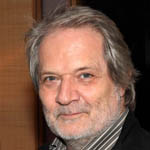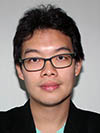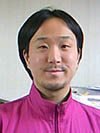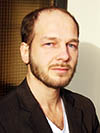Toru Takemitsu Composition Award
4 Finalists selected for Toru Takemitsu Composition Award 2014
[Judge: Peter Eötvös]
6 Dec, 2013
Peter Eötvös, judge of the Toru Takemitsu Composition Award 2014, has chosen the following 4 orchestral works out of 108 entries from 31 countries eligibly accepted by 30 September 2013. Screening was done with the anonymous scores having only their titles.
These four nominated works will be performed on 25 May 2014 at the Tokyo Opera City Concert Hall : Takemitsu Memorial for Mr. Eötvös’s final judgement.
Here is the list of finalists in order of their entry.
Applications for 2014(PDF/238KB)
- Year 2014 Peter Eötvös (Hungary)
-

© Wilfried Hoesl
Finalists (in order of entry)
Siraseth Pantura-umporn (Thailand)
AWAKENING / SERENITY
Born in Bangkok, Thailand in 1982. Self-taught music composition from 15 years of age and forwarded his study to the Department of Music, Chulalongkorn University, Thailand where he studied music composition with Prof. Narongrit Dhamabutra and Prof. Weerachat Premananda. In 2002, he won the 23rd Irino Prize for Orchestra in Japan. In 2004-2006, He won the Young Thai Artist Award 3 times consecutively. In 2006 he was selected composer in the Thailand International Composition Competition for Saxophone.
His works have been performed by various groups of musicians e.g. New Japan Philharmonic, Orchestra Internazionale d’Italia, Ensemble Kochi, Ensemble TIMF, Luxembourg Sinfonietta, etc. in several countries such as Thailand, Cambodia, Myanmar, Malaysia, Singapore, Philipines, Hong Kong, Japan, Korea, Indonesia, Europe and America.

Timo Ruttkamp (Germany)
BLACK BOXES für drei Orchestergruppen
Born in Hagen, Germany in 1980. He studied composition and electronic composition with York Höller and Hans Ulrich Humpert at Cologne Conservatory. He passed additional studies at CNSMD in Paris with Frédéric Durieux and at McGill-University in Montréal. His honours include several scholarships and prizes for composition, e.g. Bernd Alois Zimmermann Prize of the city of Cologne 2008, 1st prize at German Music Competition for Composition 2010 and 6 months scholarship for the Cité Internationale des Arts in Paris in 2011 by the German government. In 2013 he was a finalist at Isang Yun International Composition Prize.
http://www.timoruttkamp.de/

Kei Daigo (Japan)
THE NORTHERN CAMELLIA - GRADATION OF SOUNDING AMITY NO.2 -
Born in Saitama, Japan, in 1979, and mainly brought up in Shiroi City of Chiba Prefecture, Kei Daigo studied composition with Teruyuki Noda, and took the bachelor (2005) degree in composition at Tokyo University of Arts. His prize-winning pieces include «Concerto for Orchestra» (Japan Symphony Foundation Encouragement Award, 2008), «Gradation of Sounding Amity No.1» (the 2nd Prize, at The All Japan Band Association Composition Award, 2009), «Good morning Complex» (the 2nd Prize, at The 78th Japan Music Competition, 2009), «Gradation of Sounding Amity No.4» (nominate, at The 23rd Akutagawa Composition Competition, 2013).

Giovanni Dario Manzini (Italy)
Until the sea above us closed again
Born in Florence, Italy in 1978. He approached composition by studying jazz harmony and piano improvisation with Tim Richards in London in 2007. In 2008 he started teaching himself classical harmony and orchestration, and in 2010 he went back to Florence and enrolled in the composition course at Scuola di Musica di Fiesole studying with Andrea Portera.
He has written concert music and soundtracks for several artists, ensembles and institutions, amongst them: Virgilio Sieni, Nuovo Contrappunto Ensemble (Florence), Orchestra I Pomeriggi Musicali (Milan), A Cappella Boğaziçi (Istanbul), Swedish Film Institute (Stockholm) and Greenpeace.
His works are published by Sconfinarte (Milan).

Comments for the Final / as a single judge
for the Toru Takemitsu Composition Award 2014
I have spent time over several decades on perusal and selection, but this was the first time I have ever received 108 scores: I alone had to make a decision as to which 4 compositions shall be part of the international concert repertoire.
It was a great challenge although the selection was far less complicated for me to do on my own. It was a pleasure to read the scores, especially since I am very interested in the younger generation’s way of musical thinking.
I do not set high value on the works of composers who come from an easily recognizable "school" where patterns of thought are already in place. You can generally tell by the outward, graphic appearance of such scores that the composer is a copyist.
As a conductor I often find that compositions which lack charisma cannot touch, cannot form a connection with the audience. A dialogue must be crafted between the composer and the audience. For the orchestra, it is extremely important that a common language should develop between the composer and the musicians within the new thoughts and techniques; and that there should be one or two moments in the course of the new piece which will be a true discovery, a revelation for the musicians and the audience alike. Originality of the musical message, clearly discernible cultural roots and clear, precise "notation": these were my criteria for the evaluation of the submitted scores.
The selection process took 6 weeks. After reading all 108 scores, 54 proceeded to the next round (exactly half of them). It took another two weeks for my brain to "process" the material. Following a second reading I was left with 18 pieces (exactly one-third). Seven of these were favorites, eleven were possible.
I made the final decision on the very last day, when I said to myself, “I am sitting in a concert hall and I would like to ask the orchestra to perform the following 4 pieces for me”:
(In order of entry)
AWAKENING / SERENITY
Reading the score I had the same feeling that I sometimes have in a foreign country, where despite the fact that I do not speak the language, I seem to understand everything; everything becomes clear and obvious in the composition. It is a piece one can recognize after hearing it only once. It is unique, singular, and very positive.
The composer uses strong, contrasting colors. The set of instruments where the glockenspiel, the vibraphone, the tubular bells, the harp, the piano and the sparkling sound of the wind chimes dominate probably represent "serenity", in opposition to the wind and string instruments that make regular attempts to "wake up". If they manage to do so, we can look forward to a serene and energetic day.
BLACK BOXES
It is easily discernible that the composer comes from the German musical heritage. The model for this piece written for 3 groups of instruments cannot have been any other than the Stockhausen piece from 1957, "Gruppen", written for 3 different orchestras.
However, it is only a model, and the "Black Boxes" is not an imitation.
While Stockhausen was interested in polyphony - the independent, individual lives of the three orchestras, perceived as the life of three countries would be seen from the cosmos - "Black Boxes" incorporates its incredibly compact and energetic material into a single frame, into one great stereo sound.
This piece is without a doubt the most traditional of the four chosen scores. Because of its extraordinarily clear, formal composition, dynamism and verve and the transparent sound that comes from constantly employing the entire orchestra, it would most certainly be a pleasure to listen to this piece sitting in the middle of the front row of the balcony.
I do hope that the premiere in Tokyo will arouse the interest of other orchestras to perform it.
THE NORTHERN CAMELLIA - GRADATION OF SOUNDING AMITY No.2 -
I read and reread this score, at length, several times. I perused it as I sometimes do with a painting, when I am in a museum, alone in a room where there is only one picture exhibited. I stand in front of the picture for a long time, taking stock of the whole, then studying the details, then looking at the whole again – and so on, for some time.
The composer has a deep knowledge of sound. He does not listen to it from outside, but from within the music. He uses a special technique that reminds one of the Impressionists: he constantly repeats sounds, as the painters used points strung together instead of lines. In this way, sounds are lifted from the ground into space: they will be lighter, and as the sound is made up of points, they can mix and mingle with each other lightly and easily, like snowflakes. The composer found an extremely simple and clear writing technique to help musicians with the performance of this repetitive sound.
I am very much looking forward to hearing a live performance of this composition.
Until the sea above us closed again
There are certain themes that are not suitable for musical transformation. In this case the exact opposite happens: it is the choice of theme and the musical refinement that makes this subdued and sensitive piece stand out from among the others. This piece is like three poems, recited in a whisper. It evokes the spirit of Dante – and the moment it becomes almost tangible, it disappears.
This piece was written for a medium-size orchestra and it is relatively short, suitable for a concert hall, but I imagine that listening to it on CD at home alone, a closer inspection would bring further details to the listener's attention.
- Thanks
My grateful thanks to all 108 composers for giving me an inside view of contemporary musical thinking and trends from all over the world. Despite the varying quality of the pieces, the overall picture is coherent and positive.
Appreciative thanks are due to the organizers of the competition, for their conscientious, thorough preparatory work and the precise information given at all times.
I look forward with great pleasure to meeting all concerned in Tokyo in May.
Peter Eötvös
November 30, 2013
Final Concert
15:00, Sun. 25 May, 2014
Tokyo Opera City Concert Hall: Takemitsu Memorial
[COMPOSIUM 2014]
Toru Takemitsu Composition Award 2014: Final Concert
Peter Eötvös, judge
Yoichi Sugiyama, conductor
Tokyo Philharmonic Orchestra
Contact us
Tokyo Opera City Cultural Foundation
3-20-2 Nishi-Shinjuku, Shinjuku-ku, Tokyo 163-1403 JAPAN
Tel. +81 3 5353 0770
Fax.+81 3 5353 0771